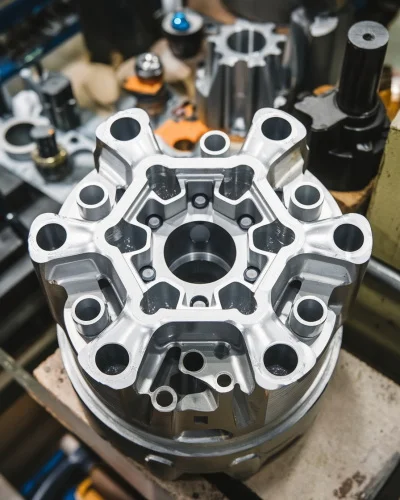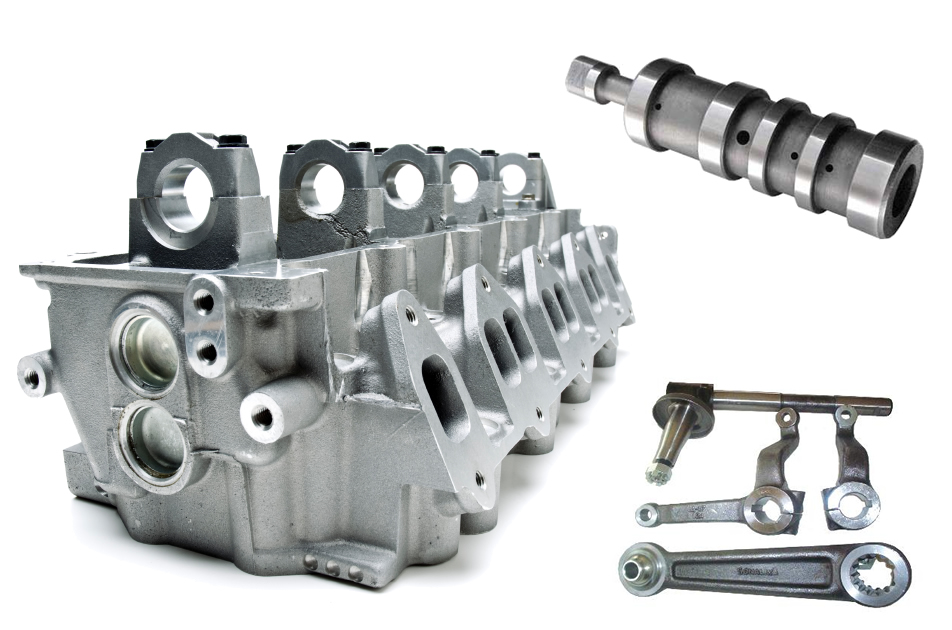Why an Aluminum Foundry is essential for innovative metal parts
Wiki Article
Checking Out the Innovative Procedures Behind Modern Light Weight Aluminum Factory Procedures
Modern light weight aluminum shop procedures are undertaking substantial transformation. Automation and AI are reshaping production techniques, enhancing both performance and precision. The integration of 3D printing is simplifying mold creation, while sustainability methods are ending up being extra necessary. Each of these improvements plays a crucial duty in redefining the sector. Nevertheless, the implications of these changes extend past plain manufacturing efficiency. What possibilities and obstacles lie ahead for light weight aluminum shops in this progressing landscape?The Function of Automation in Aluminum Foundries

Additionally, automation adds to boosted safety standards within the factory atmosphere. By moving harmful jobs to machines, human workers can focus on supervisory functions and high quality control, decreasing the risk of accidents. On top of that, information analytics obtained from automated processes supply useful insights right into functional performance, bring about better decision-making and constant renovation. As the demand for aluminum items grows, the adoption of automation modern technologies will likely increase, additionally transforming the landscape of aluminum foundry operations.
Improvements in Casting Technologies
Recent developments in casting innovations are transforming aluminum shop procedures. Innovations such as 3D printing integration, progressed alloy formulas, and automated procedure optimization are boosting efficiency and item high quality. These advancements are essential in meeting the progressing demands of the sector.3D Printing Combination
Incorporating 3D printing modern technology right into light weight aluminum shop operations has actually transformed standard casting methods, boosting both efficiency and precision. This innovative method enables the fast manufacturing of complicated molds and cores, significantly decreasing preparations and product waste. By utilizing additive production, shops can produce complex geometries that were impossible or previously challenging to achieve with standard techniques. The flexibility of 3D printing also makes it possible for quick style adjustments, cultivating an extra agile manufacturing process. On top of that, this combination supports making use of lightweight structures, which is progressively vital in industries such as vehicle and aerospace. As aluminum shops remain to embrace 3D printing, they position themselves at the center of technical improvement, driving improvements in product high quality and operational capacities.Advanced Alloy Formulations
The advancement of innovative alloy formulas has considerably improved spreading technologies in aluminum foundry procedures. These solutions integrate different components, such as copper, magnesium, and silicon, to boost mechanical homes and thermal resistance. By customizing the make-up of aluminum alloys, producers can accomplish certain efficiency features that satisfy the needs of diverse applications, from vehicle parts to aerospace structures. The use of sophisticated alloys additionally contributes to minimized weight and raised toughness, which are crucial variables in modern design. Furthermore, technologies in alloy growth enable far better fluidity during spreading, causing improved surface coatings and decreased problems. Generally, advanced alloy formulas represent a substantial leap ahead, placing light weight aluminum shops to satisfy the progressing requirements of numerous industries properly.Automated Refine Optimization
Developments in casting modern technologies have actually led the way for automatic procedure enhancement in light weight aluminum foundry operations. By incorporating sophisticated software application and real-time data analytics, shops can currently improve manufacturing processes and improve top quality control. Automated systems keep an eye on variables such as stress, temperature level, and cooling rates, enabling immediate modifications that decrease defects and waste. Furthermore, maker knowing formulas analyze historical efficiency information to forecast suitable setups, thereby boosting performance and decreasing cycle times. Robotics additionally play a significant role, handling repeated tasks that improve safety and precision. In general, these developments not just drive functional efficiency but also make it possible for factories to satisfy the expanding need for top quality light weight aluminum parts in different sectors.Smart Manufacturing and Industry 4.0 Assimilation
The integration of Smart Production and Industry 4.0 within light weight aluminum foundries is changing functional effectiveness. By leveraging IoT innovations, automation, and robotics, foundries can enhance manufacturing processes and minimize downtime. Furthermore, data analytics provides critical understandings that boost decision-making and drive continual renovation.IoT in Factory Operations
As makers increasingly welcome the Internet of Things (IoT), shop procedures are experiencing a transformative shift in the direction of clever manufacturing and Sector 4.0 combination. Aluminum Casting Company. IoT modern technologies allow real-time information collection and analysis, improving decision-making procedures and operational effectiveness. Sensors and linked gadgets check equipment efficiency, material use, and environmental problems, allowing for proactive maintenance and resource optimization. This connectivity cultivates an extra dexterous production setting, where changes can be made promptly in action to market demands. In addition, IoT promotes improved traceability and top quality control, as data from the entire production cycle can be quickly accessed and evaluated. On the whole, the integration of IoT in foundry operations considerably boosts performance and drives development in light weight aluminum manufacturing proceduresAutomation and Robotics Combination
Automation and robotics integration is reinventing light weight aluminum foundry procedures by improving performance and accuracy. This transformative technique improves procedures such as molding, pouring, and finishing, reducing human mistake and boosting result consistency. By using innovative robotic systems, factories can attain higher production rates while maintaining rigid top quality criteria. Automated systems additionally enable real-time surveillance and flexible control, permitting for speedy adjustments to manufacturing specifications. Furthermore, the assimilation of robotics decreases labor expenses and alleviates security threats connected with hands-on handling of molten steel. As foundries welcome clever manufacturing principles intrinsic in Market 4.0, the harmony between automation and robotics solidifies their one-upmanship, leading the way for sustainable growth and development in the aluminum casting market.Data Analytics for Performance
Harnessing information analytics substantially enhances effectiveness within light weight aluminum shop procedures, straightening with wise production and Market 4.0 concepts. By leveraging real-time information collection and evaluation, factories can check manufacturing procedures, forecast devices failures, and enhance resource allotment. This data-driven approach promotes insightful decision-making, allowing managers to identify traffic jams and enhance operations. Additionally, anticipating analytics encourages factories to expect market demands, thus lowering waste and ensuring timely product distribution. Assimilation of information analytics with IoT tools boosts functional exposure, cultivating a proactive upkeep culture. Eventually, carrying out these innovative analytical strategies not just boosts productivity yet also drives advancement, positioning light weight aluminum factories to satisfy the advancing needs of the market while keeping one-upmanships in a quickly changing landscape.Lasting Practices in Aluminum Casting
While the light weight aluminum casting industry has traditionally dealt with ecological challenges, numerous shops are now embracing sustainable techniques to minimize their impact (aluminum casting). A considerable focus has actually gotten on recycling aluminum scrap, which not only minimizes waste but also preserves power contrasted to main aluminum production. Innovative melting modern technologies, such as induction heaters, enhance power efficiency and lower greenhouse gas emissionsFurthermore, factories are executing closed-loop water systems to lessen water consumption and minimize thermal pollution. Making use of green binders in mold-making procedures is getting grip, more lowering dangerous exhausts.
Furthermore, some read this article centers are investing in renewable resource resources to power operations, aligning with worldwide sustainability objectives. By integrating these methods, the aluminum spreading market is developing towards a much more environmentally accountable future, showing that economic growth can coexist with eco-friendly stewardship - Aluminum Casting Company. These initiatives reflect a commitment to sustainability and the value of environmental accountability in manufacturing
Quality Control Innovations
As the light weight aluminum casting industry breakthroughs in the direction of sustainability, the relevance of quality assurance developments ends up being increasingly obvious. Modern light weight aluminum factories are taking on sophisticated modern technologies to improve their quality assurance processes. Methods such as real-time tracking and data analytics permit makers to spot defects and disparities early in the production cycle. Applying automated inspection systems geared up with machine discovering algorithms assurances that products satisfy strict quality requirements while decreasing human error.In addition, the integration of non-destructive screening methods, such as ultrasonic and radiographic assessments, supplies find much deeper understandings into the honesty of spreadings without damaging the material. These advancements not just enhance item integrity yet additionally reduce waste, straightening with sustainability objectives. Additionally, the fostering of standardized quality frameworks helps simplify operations across different foundries, assuring consistency in output. Collectively, these developments are improving high quality control, promoting a culture of quality within the aluminum spreading industry.
Future Patterns in Aluminum Foundry Procedures
What innovations exist in advance for aluminum factory operations? The future of light weight aluminum shops is poised for change through advancements in automation, fabricated intelligence, and lasting techniques. The combination of robotics and automated systems is anticipated to improve efficiency and accuracy in the spreading processes, reducing human error and labor prices. Additionally, AI-driven analytics will enable real-time tracking and predictive upkeep, enhancing operational performance and lessening downtime.Sustainability remains a prime focus, with factories progressively adopting green practices, such as making use of recycled light weight aluminum and developing low-emission melting technologies. Technologies in 3D printing are likewise prepared for to transform mold-making, permitting intricate geometries and minimized product waste. As the sector accepts digitalization, data-driven decision-making will certainly come to be pivotal, enabling shops to respond promptly to market demands. Collectively, these fads assure to redefine aluminum factory procedures, making Going Here them extra reliable, lasting, and versatile to future challenges.

Frequently Asked Questions
What Safety Measures Are Carried Out in Light Weight Aluminum Factory Workflow?
Aluminum foundry procedures carry out different precaution, including personal safety devices, air flow systems to manage fumes, regular security training, emergency situation feedback plans, and rigid monitoring of temperature and devices to avoid mishaps and warranty worker safety.Exactly How Do Foundries Handle Workforce Training for New Technologies?

What Products Are Frequently Reused in Aluminum Foundries?
Aluminum factories frequently reuse scrap aluminum, consisting of post-consumer products like beverage canisters, vehicle parts, and building products. This reusing process reduces waste and saves sources, adding to a much more lasting light weight aluminum manufacturing market.Just How Does Light Weight Aluminum Casting Effect the Environment?
Aluminum casting influences the setting via energy-intensive processes, greenhouse gas emissions, and prospective local contamination. Advancements in reusing and sustainable methods can reduce these results, advertising an extra green method to aluminum manufacturing.What Are the Regular Lead Times for Light Weight Aluminum Spreading Projects?
Common lead times for aluminum casting projects differ substantially, normally varying from two to six weeks. Variables influencing these timelines include complexity, order dimension, and product accessibility, impacting total production schedules in foundry procedures.
Automation significantly plays an important role in light weight aluminum shops, boosting effectiveness and accuracy in the production process. Developments in casting technologies have actually paved the method for computerized process improvement in aluminum shop operations. Utilizing information analytics substantially enhances effectiveness within aluminum shop procedures, straightening with smart manufacturing and Sector 4.0 principles. A considerable emphasis has been on reusing aluminum scrap, which not just decreases waste yet additionally saves energy compared to primary aluminum manufacturing. Aluminum shops commonly reuse scrap aluminum, including post-consumer items like beverage cans, auto parts, and building products.
Report this wiki page